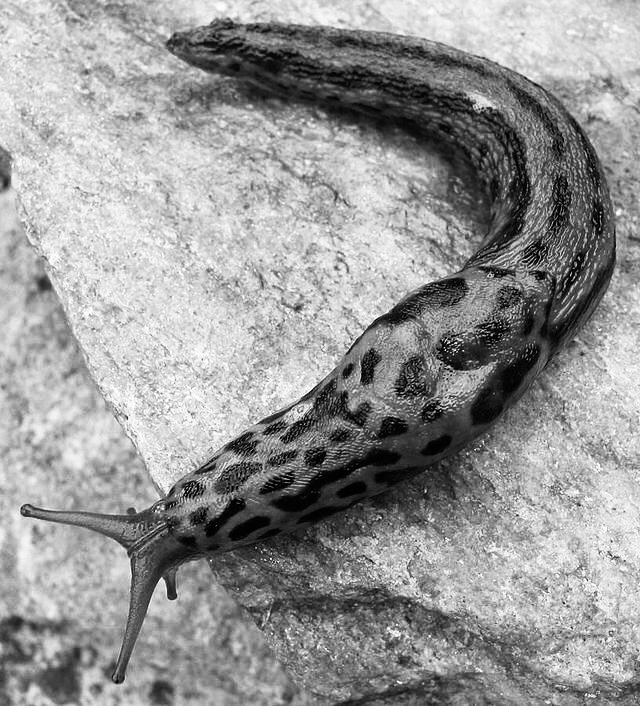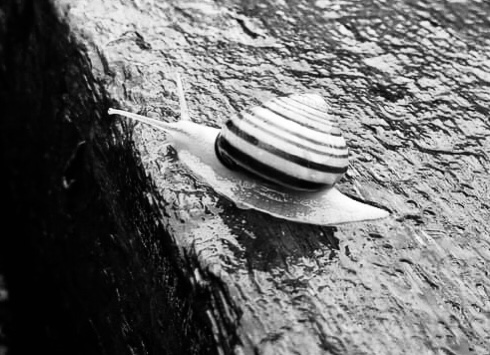
LEOPARD SLUGS
In the morning after the damage is done, a trail of slime is evidence that slugs are feasting in your garden. Gardeners have many different favorite plants to grow; annuals, perennials, flowers and vegetables. There is one thing all gardeners agree on, our common hatred of slugs.
Slugs devour all types of vegetation, especially when it’s young and tender. Left unchecked repeated slug attacks will soon bring your plants to ground level. Dahlias for one, can be hard to grow if slugs are permitted to repeatedly eat it as it breaks the ground.
In New Jersey our common ‘leopard slugs’ are not native but were accidently bought here by the Europeans. Since then, it has spread to become a common garden pest in the northeast.
Although the slimy trail is disgusting to humans, slugs could not survive without it. The foul tasting covering of slugs is its main defense against predators. Once tasted most animals will not come back for a second taste. Two exceptions are skunks and possum which include slugs in their daily diets.
The slime is also a home tracking device. If a slug goes on a journey, it can follow the scent of its trail back to its territory in the morning.
Slug slime also plays a major role in a slug’s mating ritual. Once a suitable mate is found, both creatures climb very high on a tree and locate a suitable branch. Once there the pair join together and create a very long slime rope on which they dangle and do the mating dance.
One summer night years ago, I let my dog Elsa out and got to witness this first hand. Hanging at least thirty feet from the branch, the pair embraced themselves and did an elaborate display you have to see to believe. Sliding back and forth I knew I was watching and ancient mating ritual, a miracle of mother nature. Although I knew this would result in hundreds of baby slugs in my garden I decided to walk away and not interfere. As the old expression says “It’s not nice to mess with Mother Nature.”
Slugs lay hundreds of eggs and the tiny critters are hungry so be aware of them. Light brown or tan when young the pattern that gives them their name, leopard slugs, appear as they get more mature.
There are some solutions for slugs, but for immediate results, hand picking gets the quickest response. I know, I know…. touching slugs, YUK! Wear disposable gloves and use a tool such as an old fork to knock the slugs into a cup of soapy water and drown them.
The best time to hand pick slugs is at night when they are active. Bring a flashlight out into the garden with the cup of soapy water and drop the slugs into it. If you have a bad infestation this task will have to be repeated. A rainy or drizzly day is also good for this task.
Laying crushed egg shells around the base of your plants creates a barrier slugs don’t like to cross as the course edges cut into the slug’s flesh.
Many gardeners use ‘diatomaceous earth’. Its soft siliceous shell has tiny very sharp edges that also create a barrier slugs will not cross. A word of caution… diatomaceous earth is light and can be blown by the wind. Wear protective covering over your eyes nose mouth and hands. The rule for all organics is “you want it on your plants, NOT IN YOUR LUNGS”.
Other controls can be simple. Water in the morning so the ground is dry at night. Don’t put mulch around Hosta or other desirable plants; that creates a hiding place for slugs. The leaves of Hosta create plenty of shade, referred to as “living mulch” so they don’t need it. Only mulch newly planted Hosta for the first year to protect them when they are tender.
Snails and slugs are related and snails can also do damage to your garden plants. Snails tend to leave tiny holes in the leaves and control is similar.
There are over one hundred species of snails in New Jersey. Actually, slugs are snails without shells.
Happy Gardening,
James

